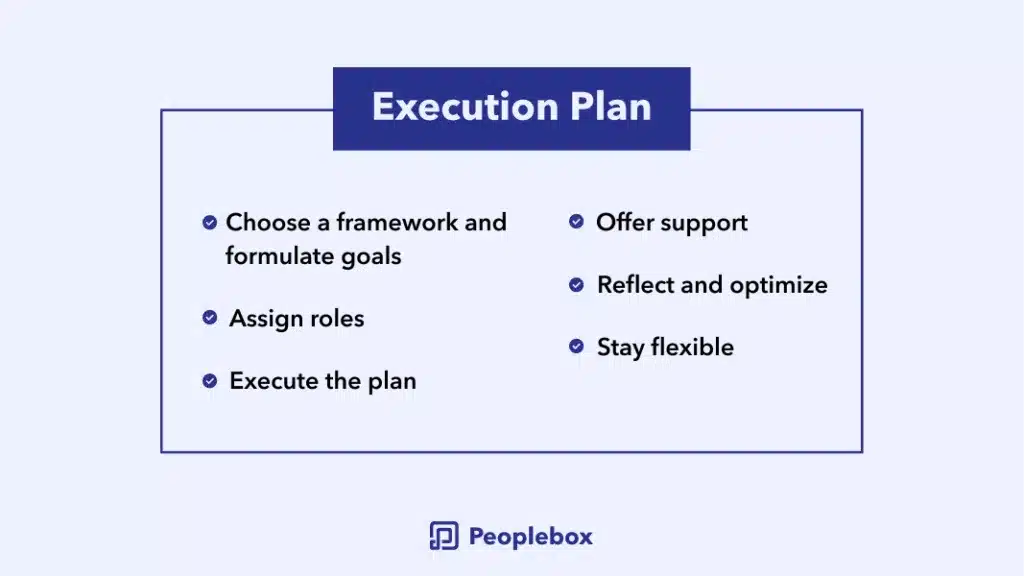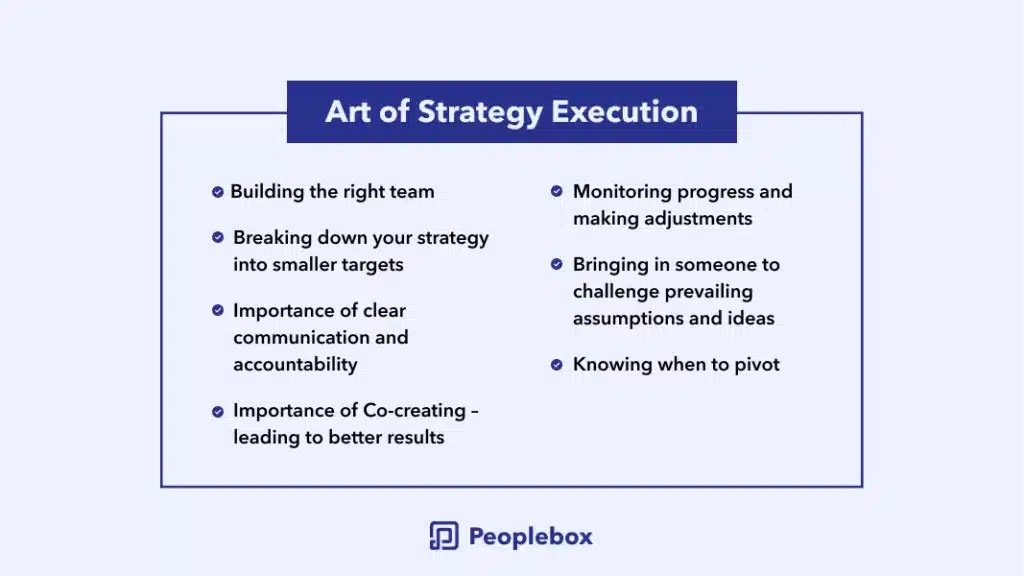In today’s competitive business landscape, success lies not only in crafting brilliant plans but also in flawless execution. But despite well-thought-out plans, many companies struggle to execute their strategies effectively.
Effective execution requires focused action, precise resource allocation, and unwavering commitment. It propels organizations towards their strategic goals, exceeding expectations and yielding unprecedented results.
Join us on a journey into the heart of strategy execution, where we uncover the secrets of successful execution. Through the stories of exceptional organizations that have mastered this art, we will reveal the core elements and proven strategies that unlock remarkable outcomes.
Without further delays, let’s dive right into the article to help you master the art of strategy execution.
What is Strategy Execution?
Strategy execution refers to the process of putting a company’s strategic plans into action to achieve its goals and objectives. It involves translating high-level strategic initiatives into actionable tasks, allocating resources, assigning responsibilities, and monitoring progress. Effective strategy execution ensures that the planned strategies are implemented successfully across all levels of the organization, leading to the realization of desired outcomes and long-term success.
Understanding the Basics: Turning Strategy into Action
Strategy execution is the process of effectively implementing a company’s strategy. It involves translating the strategy into action plans, allocating resources, and monitoring progress. To excel at strategy execution, a comprehensive approach is necessary.
Key Points to Consider:
- Strategy execution requires a disciplined and systematic approach.
- Collaboration and engagement across all levels of the organization are essential for successful execution.
- Involving employees taps into their creativity, expertise, and insights, leading to better outcomes.
- Alignment of the company’s culture, leadership, and systems with the strategy is crucial.
- Continuous learning and adaptation are vital for effective strategy execution.
- Companies should be open to experimentation, learning from both successes and failures.
- Adopting an agile and entrepreneurial mindset helps organizations stay ahead in a rapidly changing market.
Mastering the art of strategy execution necessitates a holistic approach that combines strategy, culture, leadership, and adaptation. By embracing these principles, companies can achieve success and create value for all stakeholders.
Strategy + Action = Success: The Key to Effective Strategy Execution
To execute a strategy successfully, you need to ensure the following five elements are in place: people, company structure, culture, systems, and resources.
1. People
The right people are critical to strategy execution. This means finding and attracting talent with the right skills and experience to execute the strategy. For example, when Apple CEO Tim Cook took over the company, he made significant changes to the leadership team to better align with the company’s focus on design and innovation. Cook recruited executives with expertise in hardware, software, and operations, and these changes helped Apple to continue its success in developing new products.
2. Company structure
The company’s structure, governance, and processes need to align with the strategy to ensure that everyone is working towards the same goals. For example, when Ford CEO Alan Mulally took over the company, he implemented a “One Ford” strategy that emphasized global integration and efficiency. Mulally restructured the company’s organization and consolidated the brand’s lineup to focus on fewer models, which allowed the company to reduce costs and increase profits.
3. Culture
The company’s culture plays a critical role in supporting the execution of the strategy. For example, Google’s culture of innovation and experimentation has been key to its success. The company encourages employees to pursue passion projects and experiment with new ideas, which has led to the development of successful products like Google Maps and Gmail.
4. Systems
The systems and processes within the organization should support the execution of the strategy. For example, Walmart’s “Everyday Low Prices” strategy required the company to invest in sophisticated supply chain systems to minimize costs and maximize efficiency. Walmart’s investment in technology has allowed the company to maintain its low-cost leadership position and execute its strategy effectively.
5. Resources
The resources, including funding, technology, and infrastructure, should be sufficient to execute the strategy. For example, when Microsoft CEO Satya Nadella took over the company, he shifted the company’s focus to cloud-based services and invested heavily in cloud infrastructure. This shift in focus and investment in resources allowed Microsoft to successfully execute its strategy and become a leader in the cloud computing market.
You should ensure that these five elements are aligned and interconnected to create a supportive and effective environment for strategy execution. By doing so, you can increase the chances of achieving strategic goals and creating value for stakeholders.
The Roadmap to Mastering Your Strategy
Before implementing a strategy, it is essential to have a deep understanding of the company’s vision, mission, values, goals, and objectives. It is also important to understand the work and workflow of employees to ensure that the strategy is feasible and achievable.
- The first step towards understanding the strategy is to have clarity about the company’s vision and mission. This provides a clear direction to employees and aligns their efforts with the company’s goals.
- Once the vision and mission are clear, the next step is to define the strategy’s goals and objectives. These should be specific, measurable, achievable, relevant, and time-bound. A clear definition of goals and objectives can help in identifying the key performance indicators (KPIs) and metrics that will be used to track progress towards achieving them.
- The next step is to assess the company’s resources and capabilities to achieve the strategy’s goals. This includes analyzing the workforce, infrastructure, technology, financial bandwidth, and other resources required to execute the strategy. It is essential to identify any gaps or limitations that may hinder the execution of the strategy and develop plans to address them.
- Understanding the work and workflow of employees is also crucial to ensuring the strategy’s feasibility and achievability. This involves understanding the day-to-day tasks and responsibilities of employees, their strengths and weaknesses, and how their work contributes to the company’s goals. This information can help in identifying any bottlenecks or challenges that may arise during strategy execution and developing plans to mitigate them.
So, make sure to work through all these crucial directions of the strategy compass before implementing a strategy.
How to Create an Execution Plan
Did you know that an astonishing 90% of organizations fail to execute their strategies successfully?
This can lead to:
- Missed opportunities
- Wasted resources
- Frustration among employees
However, there are proven ways to master the art of strategy execution.
Here we will explore the critical components of successful strategy execution and provide actionable steps to help you create a robust execution plan. By following these tips, you can successfully execute your strategies that result in desired outcomes.

1. Choose a framework and formulate goals
The framework should align with the company’s strategic objectives, culture, and vision. For instance, if the company values collaboration, a framework such as OKRs (Objectives and Key Results) that emphasizes teamwork and transparency might be the best fit. Once you have selected a framework, formulate clear and specific goals that are measurable, achievable, and aligned with the company’s vision and values. This will help ensure that everyone is working towards the same objectives.
2. Assign roles
Each team member should have a clear understanding of their role and how it contributes to the overall strategy. This helps to avoid confusion and ensure accountability. When assigning roles, consider the team members’ skills, experience, and interests. For example, if a team member has a talent for data analysis, they might be assigned to oversee the data analytics part of the strategy.
3. Execute the plan
Execution is the heart of strategy implementation. Execute the plan according to the timeline and milestones, and track progress regularly. This helps to identify potential roadblocks and challenges early on and make adjustments as needed. It’s essential to communicate regularly with team members and stakeholders to ensure that everyone is aligned and aware of any changes in the plan.
4. Offer support
Offering support to the team members is crucial for the overall success of the execution plan. This includes providing them with the necessary resources, training, and feedback. It’s also essential to acknowledge their efforts and celebrate their achievements. Positive reinforcement can go a long way in motivating the team members and creating a positive work environment.
5. Reflect and optimize
Reflecting on the progress and learnings regularly is essential for optimizing the execution plan. This involves analyzing the data, identifying what worked and what didn’t, and adjusting the plan accordingly. It’s also important to document the learnings for future reference and share them with the team members. This helps to improve the execution plan continually and increase the chances of success.
6. Stay flexible
Staying flexible and adapting to the changing circumstances is critical for successful strategy execution. External factors such as market trends, customer needs, or technological advances can impact the plan. Being flexible allows the team to pivot quickly and make necessary adjustments to ensure that the plan is still aligned with the company’s strategic objectives. However, it’s important to balance flexibility with consistency to ensure that the plan is still executed effectively.
Important Practices for Mastering the Art of Strategy Execution
Mastering the art of strategy execution requires not only a well-thought-out plan, but also a set of important practices to ensure success. In this section, we’ll explore some of the key practices that you can adopt to improve their strategy execution process.

1. Building the right team
You know that the success of your company depends largely on the people you hire. To execute a strategy effectively, you need to build a diverse and inclusive team with the necessary skills and experience. Encourage collaboration, innovation, and risk-taking. Foster an environment where your team members feel empowered to contribute their best work and ideas.
2. Breaking down your strategy into smaller targets
By breaking down your strategy into smaller targets, you not only make it more manageable but also ensure that tasks remain in the forefront for everyone to focus on. It’s easy for long-term goals to fade from memory when they’re not actively being worked on.
However, implementing a framework like OKRs can help address this issue. OKRs provide a structured approach to setting and tracking goals, aligning teams, and fostering accountability. They establish clear objectives and measurable key results that keep everyone engaged and focused on achieving the desired outcomes. OKR is different from KPIs, as with OKRs, you can bridge the gap between long-term vision and day-to-day execution, keeping goals visible and top of mind for continuous progress.
3. Importance of clear communication and accountability
Clear communication is key to executing a strategy successfully. You need to communicate the strategy and goals clearly to the team members, using language that everyone can understand. Encourage open communication, feedback, and accountability. Make sure that everyone knows what their role is, what’s expected of them, and how their contributions fit into the larger picture.
4. Importance of Co-creating – leading to better results
Involving your team members in co-creating the strategy and execution plan is crucial. This fosters ownership, commitment, and alignment. Your team members will have a sense of ownership over the strategy and be more motivated to execute it effectively. Additionally, by involving your team members, you’ll be able to leverage their expertise and experience, leading to better results.
5. Monitoring progress and making adjustments
Monitoring progress regularly and making adjustments based on feedback and results is critical to strategy execution. This helps to ensure that the strategy remains relevant and achievable. You can course-correct as needed, making changes to your execution plan or strategy based on what’s working and what’s not.
6. Bringing in someone to challenge prevailing assumptions and ideas
It’s easy for a group to fall into groupthink and become too focused on one way of doing things. Bringing in an outsider or a consultant to challenge prevailing assumptions and ideas can be extremely valuable. This helps to avoid groupthink and encourages fresh thinking and innovation. It’s an opportunity to bring in new ideas and perspectives that can take your strategy execution to the next level.
7. Knowing when to pivot
Being open to pivoting or changing the strategy if the circumstances demand it requires flexibility, agility, and an entrepreneurial mindset. In today’s fast-paced business world, circumstances can change quickly, and you need to be able to pivot when necessary. This requires careful evaluation of your strategy and execution plan, so you can determine when it’s time to make changes.
Mistakes to Avoid When Executing a Strategy + Solutions
In order to successfully execute a strategy, it is important to avoid common mistakes that can lead to failure. This section will outline some of the most common mistakes to avoid, as well as provide practical solutions to overcome them.
1. Unrealistic plan
One of the biggest mistakes that companies make in executing their strategies is creating unrealistic plans that are too ambitious or unachievable. While it’s important to set high goals, it’s equally important to ensure that they are realistic and achievable within the given time frame.
Executives should focus on creating a plan that is grounded in data, market insights, and achievable milestones. This helps to ensure that the team remains motivated and committed to the strategy, and progress towards the goals is consistent and measurable.
2. Rigid planning and execution
Another common mistake is being too rigid in planning and execution. While it’s important to have a plan, it’s equally important to be open to feedback, learnings, and adjustments. You should encourage an agile and iterative approach to execution, where the team can test and learn from their actions, and adapt as needed. This helps to ensure that the strategy remains relevant and effective, and the team remains engaged and invested in the process.
3. Not communicating well
One of the key factors in successful strategy execution is clear communication. You should ensure that the strategy and goals are communicated clearly to the team members, and that everyone understands their role in executing the strategy.
They should also encourage open communication, feedback, and accountability, so that issues can be identified and addressed in a timely manner. This helps to ensure that the team remains aligned and focused on achieving the goals, and progress is consistent and measurable.
4. Not defining roles and responsibilities clearly
Another common mistake is not defining the roles and responsibilities of the team members clearly. This can lead to confusion, overlap, or duplication of effort, which can slow down progress and lead to frustration. You should ensure that everyone understands their role in executing the strategy, and that there is clarity around who is responsible for what. This helps to ensure that the team remains focused and efficient, and progress towards the goals is consistent and measurable.
5. Missing alignment
One of the biggest challenges in strategy execution is ensuring that the strategy is aligned with the company’s vision, mission, values, and goals. You should ensure that the strategy is aligned with the broader organizational goals and objectives. This way everyone understands how their work contributes to the overall success of the company.
What’s more, aligning individual/team plans and strategies with the broader goals ensures that every level of the organization is working cohesively towards the shared objectives. This further helps to ensure that the team remains motivated and committed to the strategy, and progress towards the goals is consistent and measurable.
6. Not tracking progress
Finally, it’s important to regularly track progress and monitor results. This helps to identify issues early and make adjustments before it’s too late. You should establish clear metrics and KPIs to measure progress towards the goals, and ensure that the team has the tools and resources they need to track and report on their progress. This helps to ensure that the team remains focused and accountable, and progress towards the goals is consistent and measurable.
Wrapping Up
Successfully executing a company’s strategy is essential for achieving its goals and staying ahead of the competition. But as we’ve seen, it’s not always easy to get it right. That’s where innovative tools like Peoplebox come in.
By leveraging cutting-edge technology, Peoplebox can help executives and their teams master the art of strategy execution. With its powerful features, such as real-time performance tracking, goal setting, and feedback management, Peoplebox can help companies stay on track and optimize their strategy execution.
So why wait?
Sign up for Peoplebox today and start taking your strategy execution to the next level!







